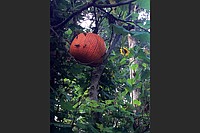Q: My sweet husband has enjoyed gardening most of his 89 years and received a surprise this year when what he thought to be a cucumber vine began growing up a nearby fig tree. Unfortunately, our fig tree has not survived the winter but has found a new purpose in supporting not a cucumber but a pumpkin! John has taken great joy in watching it evolve and I wanted to pass this along to you as an item of interest. We look forward to your column each Saturday and have learned a great deal from you and your readers over the years. We have a favorite saying stitched on a pillow that says, "Gardeners live longer awaiting another Spring." His 89+ years certainly attest to this.
A: Instead of a partridge in a pear tree, you have a pumpkin in a fig tree! I am glad you added some support to the fruit or it may have brought the whole vine down with its weight. Thanks for sharing.
■ ■ ■
Q: We have been told this vine is very invasive and needs to be removed from hedges and retaining wall [the reader sent a photo]. We can testify to how invasive it is but were curious what it is and if it will damage our hedges.
A: The vine in question is Carolina moonseed, Cocculus carolinus. It is a native vine that has pale flowers in the summer followed by berries that turn a bright red in the fall. The birds love them, but they are not edible for humans. It can be showy with its fruit, but it also can be aggressive in the garden and growing where it wants to. I have seen it growing amidst other plants and having the showy berries in the fall, but just don't let it take over the entire plant.
Photo Gallery
In The Garden — August 14, 2021
Photographs to accompany Janet Carson's "In the Garden" column for August 14, 2021.
Q: I have a raised bed garden just full of healthy herbs. This appeared and, with its lantern bloom and little yellow flowers, I thought it was so cute, but it's getting larger and larger. I don't think I planted it. Probably a weed but I wondered what it was. If you open the lantern bloom there is a large black seed.
A: The plant in question is a ground cherry. Once the papery husk starts to dry, the resulting yellow fruit inside is slightly smaller than a cherry tomato and tastes like a sweet tomato. They are edible and can be eaten raw or made into sauces. A similar plant is the tomatillo, also called husk tomato. The fruits are larger and somewhat sticky in the papery hull and are green at maturity. Salsa verde is made from these. I don't like them raw, but I do like the salsa I make from them.
■ ■ ■
Q: Can you help me with my Crape Myrtle? Half looks dead. The back side looks dead. ... If I have to cut the trunks down, I would like to know how low to go. Help!
A: I would say you had some winter damage, but a good portion has also recovered and is blooming. If you can get in and prune, remove all the dead trunks as close to the ground as you can. You have way too many trunks as it is, so I think over time it will actually be a healthier and prettier plant for your garden. Prune what you can now without damaging the healthy portion, and maybe mark those you can't easily remove to do next February.
Retired after 38 years with the University of Arkansas Cooperative Extension Service, Janet Carson ranks among Arkansas' best known horticulture experts. Her blog is at arkansasonline.com/planitjanet. Write to her at P.O. Box 2221, Little Rock, AR 72203 or email jcarson@arkansasonline.com

